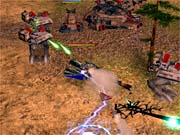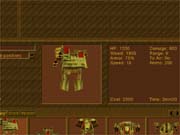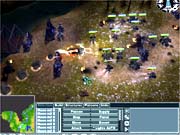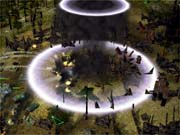Earth 2150: Lost Souls is the third game in the Earth 2150 series. The first two, Earth 2150 and Earth 2150: The Moon Project, were great 3D real-time strategy games that were very deep and involving. Lost Souls certainly follows its predecessors in that regard--it's more like a stand-alone mission pack than a true sequel. This is both good and bad. On the one hand, die-hard fans of the series newcomers alike will find a lot to like in the game. But most anyone else would consider Earth 2150: Lost Souls to be essentially just a rehash.

Lost Souls once again places you on a doomed Earth in the year 2150. Nuclear wars have knocked Earth out of its orbit and into a collision course with the sun. Some of the planet's inhabitants were able to escape to Mars in the previous two games, but a good number of people were left behind to perish. Now three Earth factions are battling against each other and desperately trying to escape before it's too late. All this boils down to some intense battles between the remnants of the Eurasian Dynasty, the Lunar Corporation, and the United Civilized States.
Unlike in the previous two games, the campaigns in Lost Souls are tied together. You'll want to go through them in order so you can get the complete story. A lot of the mission types are very similar to the previous games' missions, though. You'll have to complete goals such as mine a certain amount of minerals or defend a base for a given period of time. There are also a couple of seemingly blatant discrepancies in the story line. In Earth 2150, you had only 180 game days to mine enough resources to build an escape vessel before the planet is engulfed in flames. You had a sense of urgency to complete missions so you could conserve what precious time you had left for future missions. Since Lost Souls takes place after the events in the first two games, you'd imagine that you'd be even more pressed for time, but the game doesn't even have a timer. Also, as the days unfolded in the first game, the weather and environments changed. You started in blizzards and frozen landscapes, which began to melt as water levels rose and Earth got closer to the sun. Eventually, the water evaporated altogether to reveal a scorched landscape. So, in Lost Souls, you'd imagine that you'd pick up at this stage of Earth's demise, but that's not the case.

There are a few elements that make the Earth 2150 games so unique. First of all, you can design your own units. You have several chassis, including land, sea, and air, that you can use to make customized units suitable for different purposes. Depending on the faction and the chassis, you can add shields and different types of weapons like rocket launchers and energy cannons. You can then store the unit design, and it will appear in your construction menu for later use. You can also give the unit behavioral orders when creating it. Second, you have a main base where you manage your forces and choose missions. After you complete a mission, you can take any leftover units and money to your main base for use in later scenarios. Since units gain experience and gradually become more powerful, it's nice to be able to retain them for future use. You can also conduct research in the game. Though, unlike in standard RTS games, where you are granted new units over the course of a campaign, you actually have to research new chassis and weapons before you can use them in Lost Souls. This is a major factor in multiplayer and skirmish games. You have to be strategic in your research order--if your opponent chooses to get energy-based weapons right away, you'll want to research shields. Being caught off guard can be devastating to your forces.
The AI in the game is quite good. The computer opponent may not be the best strategic thinker, but it will still be a challenge. Your units will try to avoid shooting each other and can auto-acquire targets. The unit pathfinding is generally good, so you'll rarely have to micromanage them to get to a destination. You'll sometimes experience issues when you have a large clump of units, however. They'll try to get around each other once the first one stops, but they'll just end up circling one another. It's not a major problem, but it's just annoying to see them endlessly dancing around.

Lost Souls uses the same 3D engine used in the other two Earth 2150 games. It is a great engine for a 3D RTS game because of its good camera control and its high level of interaction between the units and the environment. Anyone who has played a lot of 3D RTS games knows that sometimes the camera can be such a disaster to control that it's better to just leave it alone. Luckily, the camera in Lost Souls is very easy to control, and it lets you zoom, elevate, and rotate your view. These functions are actually very useful in determining which weapons your opponents have mounted onto their chassis.
The engine is also great for gameplay mechanics. You can speed up or slow down the game to help you coordinate your attacks, which is especially useful when you're being attacked on several fronts. There are even some mechanics designed to surprise and fool your enemy. There are night cycles to set up ambushes in the dark, and you can have your repairers paint your units so they're the same color as your opponent's units. While these ploys aren't that functional against computer players, you'll find that they can be effective in multiplayer games if executed correctly. The game treats the environment as a 3D landscape. Flying units will have to increase altitude to pass over mountains, and hills will block weapon fire. In fact, any object will block fire. That means your defenses will accidentally hit your own buildings with stray rockets if your base isn't designed with that possibility in mind. Another interesting feature is the fact that destroyed units and buildings remain on the battlefield as destroyed husks. While you can just run over destroyed units, the charred remains of the larger buildings will become an obstacle until the remains are destroyed. This can be a hindrance to both the attacker and defender, and usually you'll see the AI move in to clear away its own destroyed buildings.
The engine's graphics are beginning to show their age, but the game definitely isn't unpleasant to look at. Weapon effects like plasma bolts and shield deflections still look quite nice, and you'll be satisfied with the good-looking explosions when you destroy something. You'll probably enjoy fighting the United Civilized States just so you can see the huge, screen-jolting explosions when you destroy nuclear reactors. But the graphics themselves are fairly bland, especially since we're seeing them for the third time. The textures just aren't that impressive, and the units look like they're made out of Lego blocks. It would have been nice to have had updated graphics, but they are still acceptable when compared with those of current 3D RTS games.

Another aspect of the series that hasn't changed in Lost Souls is the sound. The sounds of weapons firing and explosions are decent, but the unit acknowledgements are still as hokey as ever. You'll wish they had at least done something about the wretched voices of the Lunar Corporation faction. Lost Souls also uses the same soundtrack found in the previous two games in the series. While the soundtrack provides a very good orchestral backdrop for the game, it's disappointing that no new tracks have been added.
Earth 2150: Lost Souls stands tall on its own merits. Its many options, long missions, and excellent gameplay make it one of the best RTS games on the market. If you've already played previous Earth 2150 games, you won't find anything new here, but if you don't mind going through the same thing again or you're just looking for a great RTS game, then look no further.



